Physical Address
304 North Cardinal St.
Dorchester Center, MA 02124
![]()
![]() Access video and video lecture content for this chapter online at Elsevier eBooks+
Access video and video lecture content for this chapter online at Elsevier eBooks+
Auricular defects can cause psychosocial morbidity to the affected patient that may be improved with surgical correction. Congenital abnormalities of the external ear are common and are comprised of a wide spectrum of presentations from complete absence to minor irregularities.
Congenital external ear anomalies are classified by etiology and may arise from mechanical events impacting fetal growth (disruptions or deformations) or from errors in embryological development (malformations). Generally speaking, in deformations and disruptions, the tissue components are present but misshapen, whereas malformations have absence of tissue components. Hunter et al . classified ear anomalies as variations in size, position, anatomical components, and named anomalies such as cryptotia, constricted ear, prominent ear, and Stahl’s ear. Acquired defects also have a large variability in presentation and are most commonly the result of trauma, burns or tumor resection.
Correction and/or reconstruction is aimed at producing an aesthetically pleasing ear by restoring anatomical features, structure, position, and proportion. Ear reconstruction is challenging due to the complex structural framework and the thin soft-tissue envelope of a normal-appearing human ear. This is evidenced by the multitude of reconstructive techniques used for microtia and other ear defects. Auricular reconstruction has evolved over trials, errors, and an appreciation of the variable techniques used to produce a durable, pleasing ear. Great strides have been made and surgeons are continuing to innovate, to refine, and improve the current state of the art.
This chapter is divided into four main sections. The first section provides a background on epidemiology, anatomy, embryology, and the history of ear reconstruction. The second section concentrates on common congenital ear deformities such as cryptotia, constricted ear, and Stahl’s ear but excludes microtia and prominent ears. Prominent ear is described in Chapter 20 in the aesthetic volume of this text (Volume 2) and is therefore not discussed here. The third section is devoted to microtia and its reconstruction. The final section is focused on partial ear defects as acquired deformities.
The first known reports of ear reconstruction were by Sushruta, considered the father of plastic surgery, possibly as early as 600 BCE. His text, the Sushruta Samhita, is considered the oldest plastic surgery text and describes the use of local flaps to reconstruct the ear lobe. Aelius Galen, a Roman surgeon during the second and third century CE, reconstructed traumatic ear defects of gladiators. Gaspare Tagliocozzi, another Italian surgeon, used procedures to restore defective ears in the sixteenth century. In Germany, Johan Friedrich Diefenbach developed techniques to reconstruct the middle third of the ear and was credited as the first to correct prominent ears in the eighteenth and nineteenth centuries. Harold Gilles pioneered reconstructive methods of the face in the early twentieth century. Although his techniques were not specific for the ear, they were the foundation for many later ear reconstructive surgeons.
Radford Tanzer, an American surgeon, performed his first microtia procedures using cartilage in the 1950s and popularized autologous reconstruction of the auricle using costochondral cartilage. Tanzer’s technique involved a multistage reconstructive process. The first stage involved repositioning usable remnant tissue with particular attention paid to the lobule. The second stage was performed after induration from the first stage had softened and involved using the contralateral 6th, 7th and 8th ribs to contour and implant the cartilage framework. The third stage was performed 4 months later and involved elevating the construct from the head and constructing the superior, posterior, and inferior conchal walls. This “third stage” was divided into three sub-stages, the first being elevation inferiorly with creation of a temporary tunnel, followed by superior elevation with enlargement of the tunnel, and then finally tunnel closure. The first two of these sub-stages were performed 2 months apart with closure of the tunnel 4 months later. Each of these three steps utilize skin grafts for coverage as necessary. The fourth and final stage involved formation of the tragus and conchal floor 6 weeks later.
Building on Tanzer’s experience, Burt Brent further advanced microtia reconstruction using autologous cartilage also in four main stages. Satoru Nagata worked to refine the four stages of Tanzer and Brent into a two-stage process in the 1990s. In Nagata’s technique, attention was paid to the skin incision pattern which provided increased skin surface area allowing for a true three-dimensional cartilage construct. In addition, there was better coverage over the tragus, and his technique avoided the use of skin grafts over the conchal region, which can result in contraction and shallowing of the bowl. Françoise Firmin transitioned from Brent’s technique to Nagata’s. Firmin implemented her own modifications of two-stage autologous reconstruction, which includes the creation of a classification system that pertains to the skin incisions, frameworks, as well as technique of second-stage elevation. The authors of this chapter, Fisher and Kasrai, trained with Nagata and modified his technique reducing the reconstruction to a single stage. The details of these technique will be described later in this chapter.
Autologous reconstruction has long been considered the standard in microtia reconstruction. In the early twentieth century, attempts were made to use alloplastic options. Alloplastic reconstruction eliminates the use of a donor site, can be performed at an earlier age minimizing psychosocial burden, and does not resorb. Early materials used in the 1940s included tantalum wire mesh, acrylic, 21 and polyethylene. Cronin was the first to use silicone for ear reconstruction in 1966. However, similar to previous alloplastic materials, high extrusion rates precluded recommendations for its use. Several other surgeons reported series using Silastic frameworks with further refinements. In 1978, Cronin and Ascough recognized that the temporoparietal fascial (TPF) flap was necessary as a soft-tissue layer to reduce extrusion. Porous polyethylene has become the most successful alloplastic material used in ear reconstruction and was first used in 1983 in conjunction with a TPF flap. Reinisch further refined the technique, reducing extrusion rates to 7%.
The birth prevalence of microtia/anotia is estimated to be between 1 in 3000 to 1 in 20,000 and there is significant variability in regional prevalence rates. Microtia has been reported to occur 20–40% more often in males with some reporting a 2:1 predominance. The majority of cases are unilateral (77–93%) and occur more frequently on the right side (60%). Microtia is associated with an identifiable syndrome 20–60% of the time and is more likely to be bilateral when there are anomalies separate from the ear abnormality. Sixty-five percent of patients with craniofacial microsomia and 60–80% of individuals with Treacher Collins syndrome are affected.
Anomalies of the external ear should prompt consideration for middle and inner ear abnormalities. Aural atresia is the most common associated condition and may involve ossicular chain disruption in addition to absence of the external auditory canal. As a result, a significant number of patients have conductive hearing loss. It also may be associated with inner ear defects. A retrospective review of 61 patients with both atresia and microtia demonstrated inner ear abnormalities in 23% of patients.
The prevalence of cryptotia has been reported as high as 1 in 400. The prevalence of Stahl’s ear is unknown, but has been reported to be as high as 8% in the Japanese population. The prevalence of constricted ear is estimated at 1 in 1000 to 1 in 2000.
The initiation of ear development begins with the otic placode at 3 weeks of gestation followed by the external auditory canal at 4 weeks. The external ear develops from six ectodermal thickenings on the first and second branchial arches beginning at 5 weeks of gestational age. These thickenings, known as auricular hillocks, are numbered from 1 through 6 ( Fig. 4.1 ). Hillocks 1 to 3 are derived from the first branchial arch, and 4 to 6 from the second branchial arch. Each hillock has been described as giving rise to particular parts of the developed ear, however there is controversy regarding exact embryologic-anatomic correlations. The auricle moves from an antero-caudal to a postero-cranial position during development. The hillocks fuse together forming the auricle at 6–8 weeks of gestation.
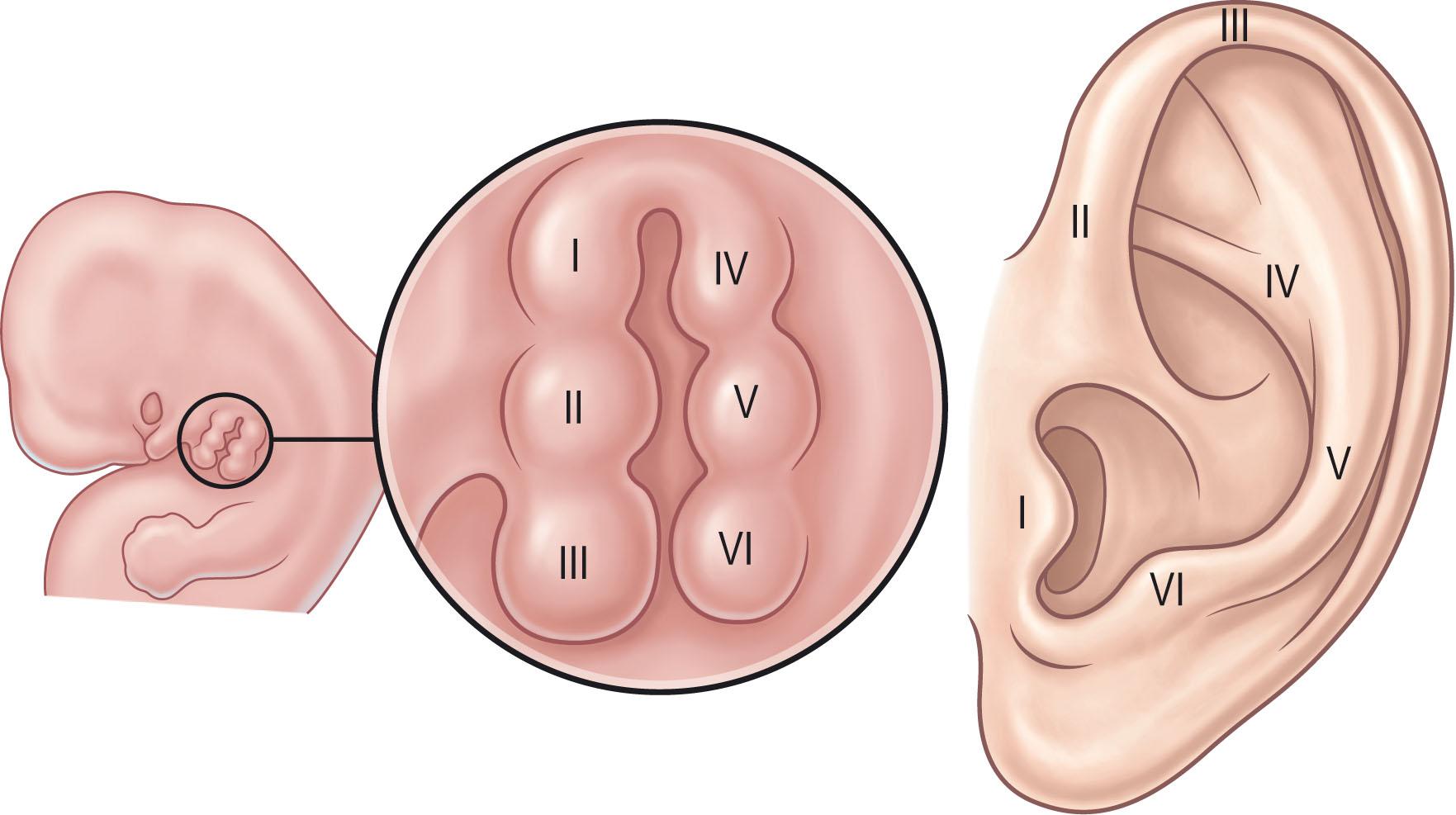
An understanding of the growth trajectory of the ear is important with respect to determination of appropriate timing for reconstruction. Farkas et al . studied anthropometric growth of ears in 1590 individuals of European descent and determined that ear length and width were 86.6% and 96.7% respectively of adult size by 5 years of age. In fact, ear width is near adult size at 1 year of age (93.5%). Length lags and is 75% of adult size at 1 year. The width of the ear reaches maturation at 6 and 7 years of age in females and males, respectively. The length of the ear reaches maturation at 12 and 13 years of age in females and males, respectively. Appropriate timing of reconstruction needs to account for both the impact of future ear growth as well as the psychosocial benefits of early intervention.
The named components of the auricle are shown in Fig. 4.2 . The helix begins at the helical root as an elevation that separates the conchal bowl into the cymba and cavum. It then curves to form the anterior, superior, and posterior extremes of the ear, ending as the helical tail and merging with the lobule. The middle third of the antihelix parallels the helix, separated from it by the scapha, its lower third projects anteriorly as the antitragus. In its upper third, the antihelix separates into the superior and inferior crura separated by a depression, the triangular fossa. The meatus of the external ear canal opens into the anterior aspect of the cavum concha caudal to the helical root. It is hidden from the anterolateral view by the tragus. The tragus projects anterolaterally and is separated from the antitragus by the intertragal notch or incisura. The lobule of the auricle lacks cartilage and has a variable attachment with the cheek. The space between the unattached auricle and the head is termed the retroauricular sulcus.

There is a large variation in the height (5.5–7.5 cm) and width (3–4.5 cm) of the adult ear. The width of the ear is 50–60% of its height with an axis of 20–30° from the vertical. The anterior extent is 6.5–7.5 cm posterior to the lateral orbital rim, with the superior border at the level of the brow protruding 1.5–2 cm laterally. The lower border of the ear is usually at the horizontal level of the columella or slightly lower. Posterolateral ear projection at the helical root is 21–25° and the conchoscaphal angle is typically around 90° ( Fig. 4.3 ). The infraorbital rim (inferaorbitale) and the upper margin of the external ear canal (porion) define the Frankfort plane. The distance from the most anterior aspect of the helix to the lateral eyebrow approximates the height of the ear.
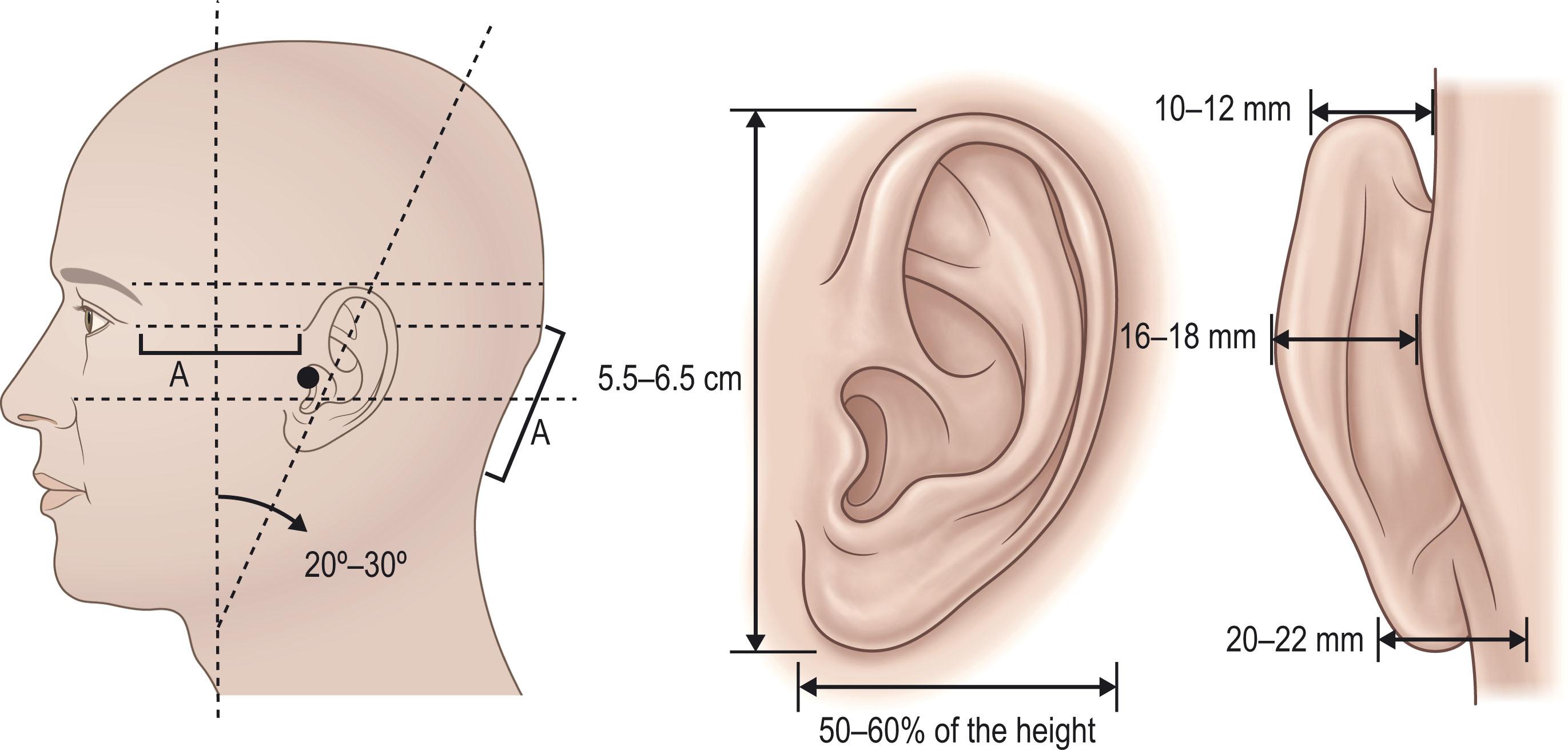
The cartilage framework of the normal adult ear contributes significantly to the structure, shape, and appearance of the external ear. The exception being the lobule, which is composed of skin and subcutaneous tissue. Fig. 4.4 demonstrates the cartilage framework present in the native ear.
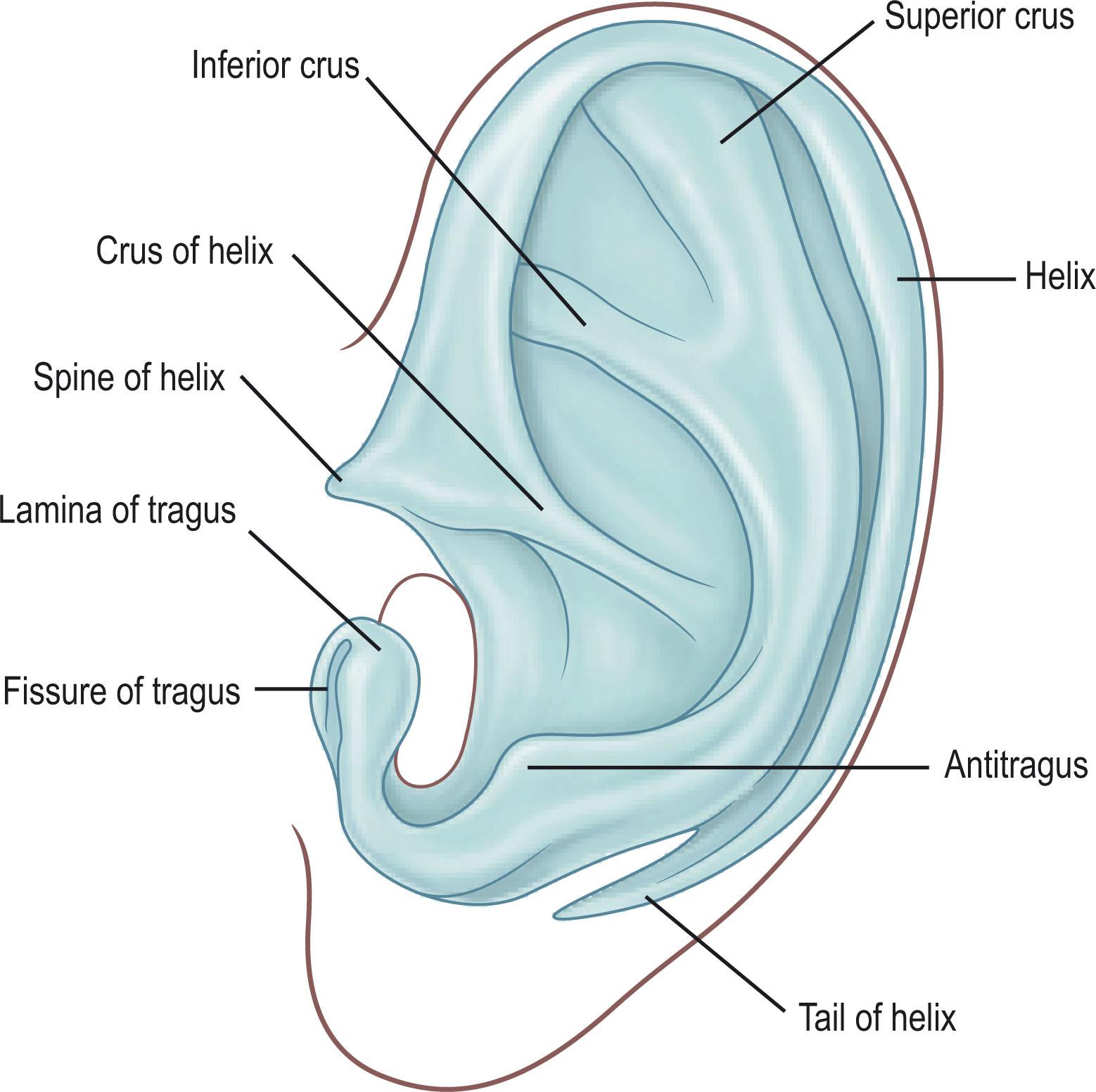
It is important to appreciate the different types of cartilage (elastic, fibrocartilage, hyaline). The ear is elastic cartilage and has different material properties than the hyaline cartilage of the rib. Similarly, alloplastic materials, which are discussed in more detail later in this chapter, have different material properties to the native ear cartilage. This represents one of the fundamental disadvantages of current ear reconstructive techniques.
The blood supply to the ear is provided by the posterior auricular artery (PAA) and superficial temporal artery (STA). Previous studies determined that the PAA is the major source vessel to the ear. Recent investigations have revisited the connections between the two main source vessels and the complex vascular arcades within the ear ( Fig. 4.5 ). The STA most commonly has superior, middle, and inferior anterior auricular branches that primarily supply the tragus, helical root, lobule, superior crus, scapha, and the helical rim arcade. The PAA emerges posteriorly and has two to four branches primarily supplying the concha, antitragus, and antihelix. The STA and PAA have perforators that anastomose with each other over the superior third of the helical rim forming the helical arcade (different to the helical “rim” arcade).
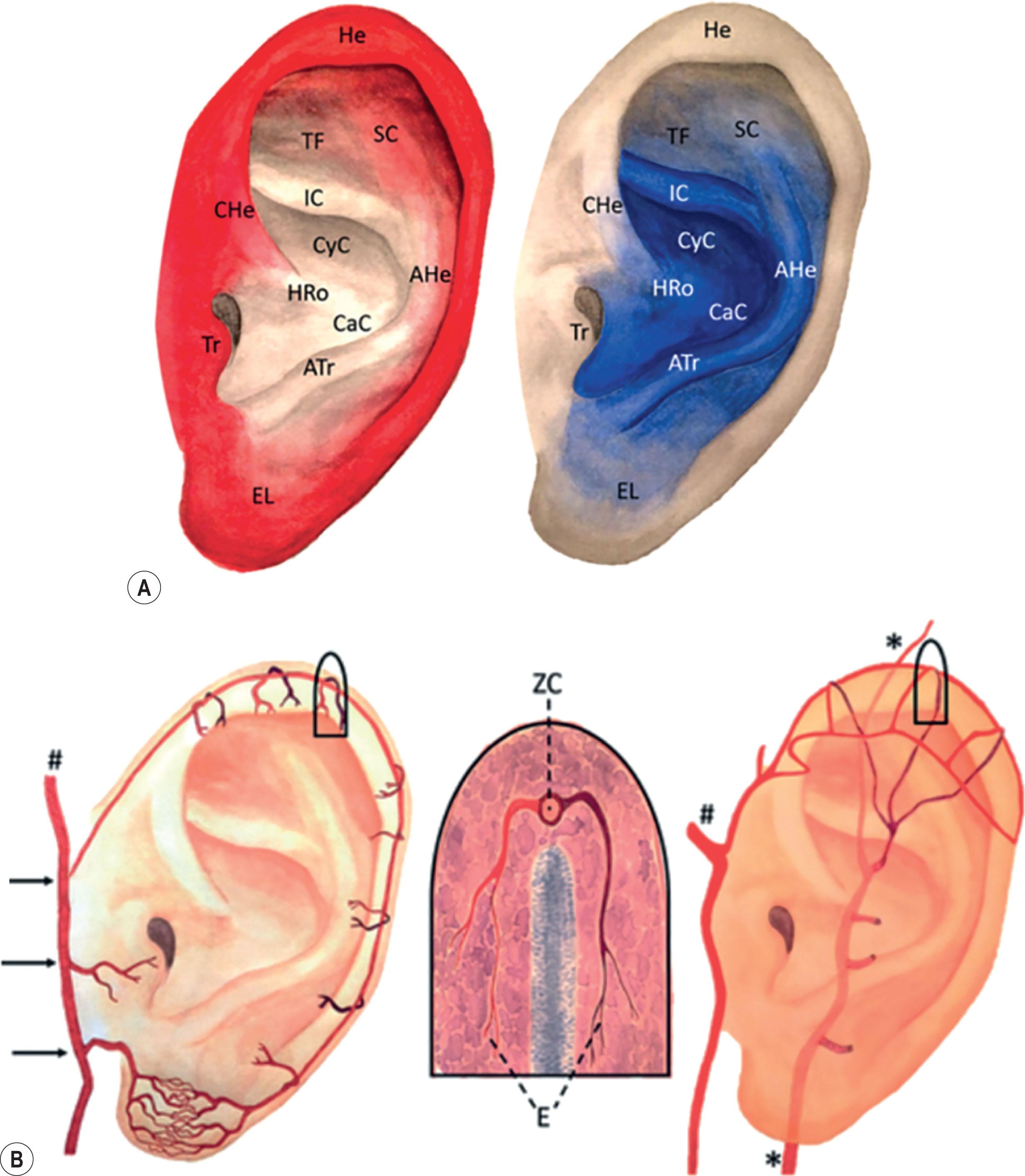
The auricle is well supported by the surrounding musculature and soft-tissue attachments, as can be seen in Fig. 4.6 . The muscular anatomy can be divided into intrinsic and extrinsic systems. The extrinsic muscles include the anterior, superior, and posterior auricularis muscles and serve to anchor the ear in place. The intrinsic muscles include the major helical, minor helical, tragal and antitragal muscles anteriorly and the auricular oblique and transverse muscles posteriorly. The intrinsic muscles provide support to the ear framework and are closely linked to intrinsic ligaments within the ear.
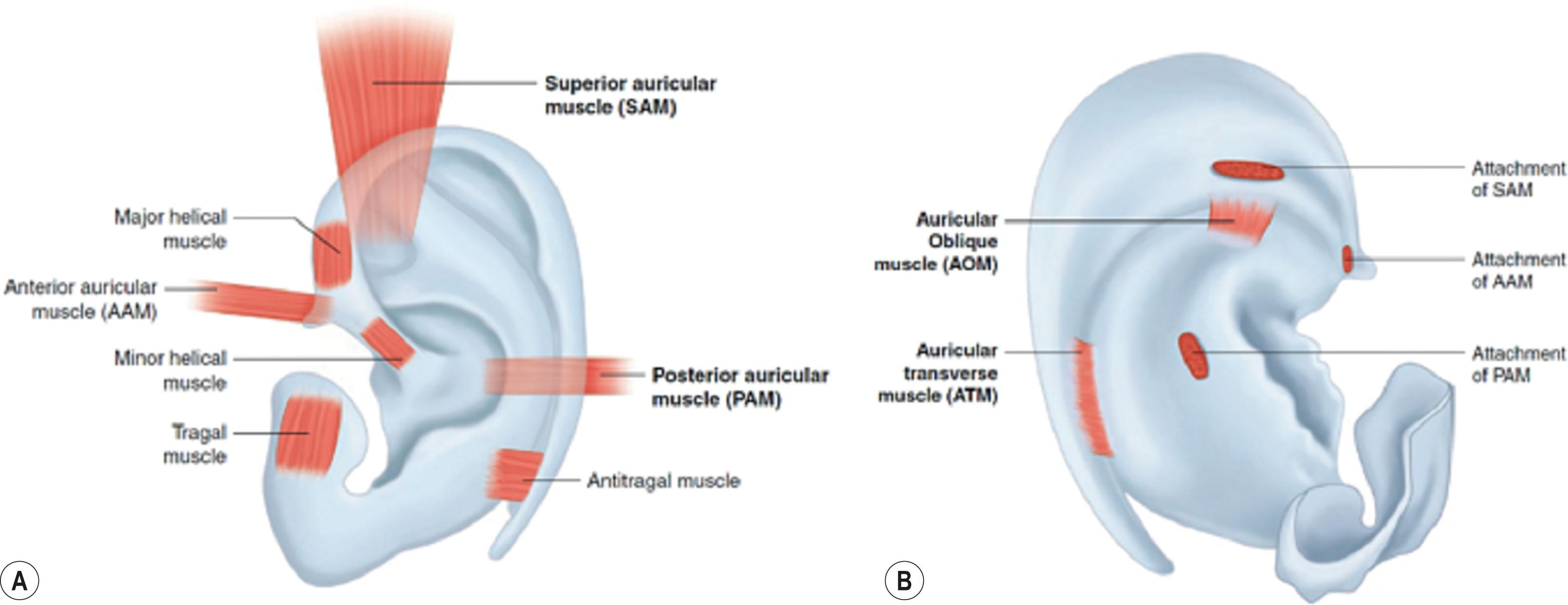
The auricle is supplied by both cranial and spinal nerves. The great auricular nerve (C2,3) provides sensation to the inferior half of the ear. The superior half of the ear is supplied anteriorly by the auriculotemporal nerve (CN V 3 ) and posteriorly by the lesser occipital nerve (C2, C3). The concha is supplied by the auricular branch of the vagus nerve (CN X), also known as Arnold’s nerve, the nervus intermedius (CN VII), and the auriculotemporal nerve ( Fig. 4.7 ).
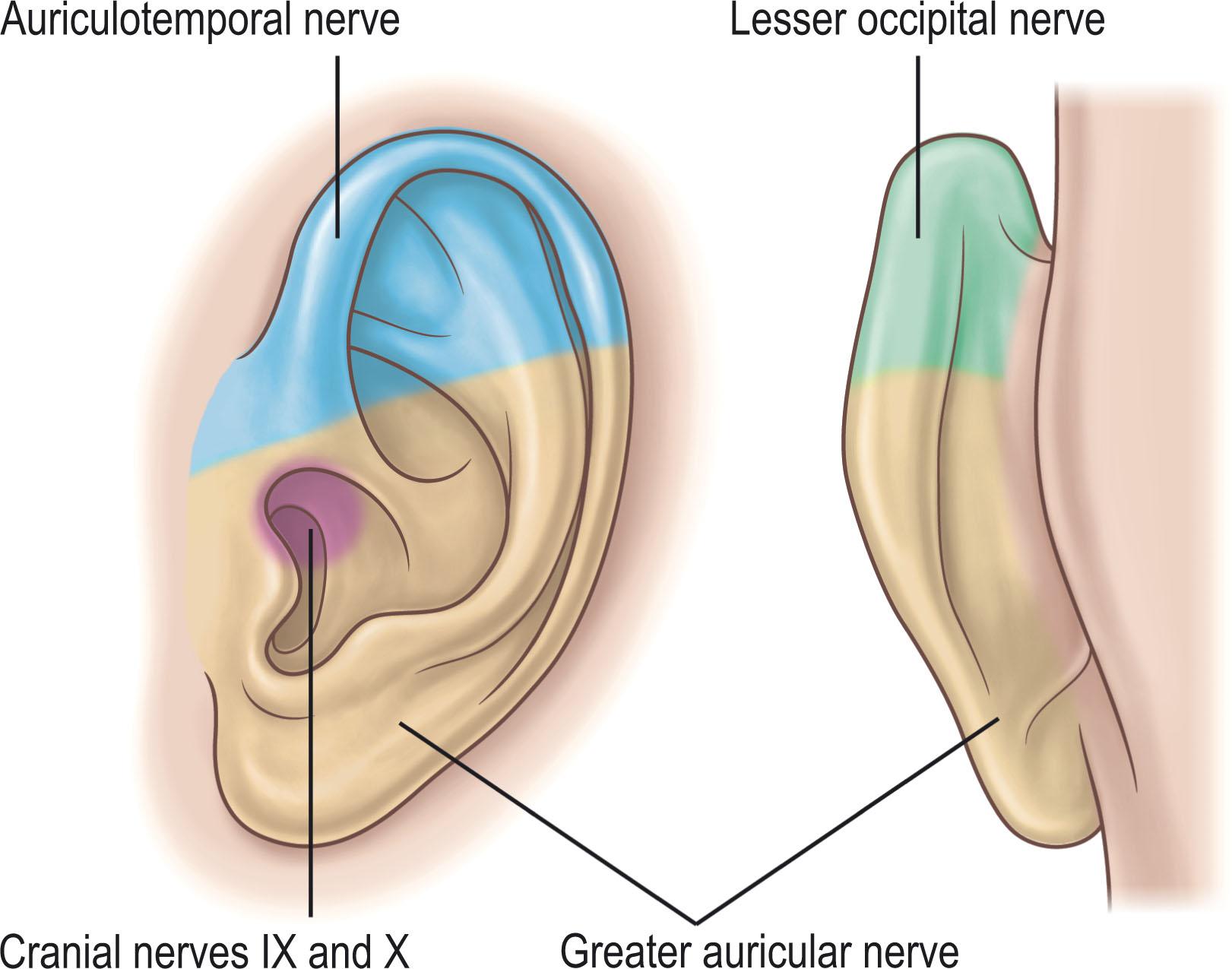
The innervation of the auricular muscles is provided by the posterior auricular nerve and temporal branch of the facial nerve. Although the function of the auricular muscles is limited, knowledge of the position of the facial nerve is important to prevent injury to more proximal facial nerve trunks. The pointed medial end of the tragus is named the “pointer”. Anatomical studies demonstrate that the facial nerve is located on average 6.9 mm (range 3.4 to 11.3 mm) away from the pointer and is usually medial, inferior, and anterior to the pointer or halfway between the pointer and posterior belly of the digastric.
There is growing evidence that both environmental and genetic factors play a large role in the development of microtia. Numerous risk factors have been reported and include maternal illness, maternal diabetes, low birthweight, maternal parity, multiple births, advanced maternal age, Hispanic ethnicity, and high altitude. Medication use during gestation has also been associated with microtia and includes retinoids, thalidomide,and mycophenolate.
Numerous genetic factors have been linked to the development of microtia. A detailed description of specific genes and signaling pathways is beyond the scope of this chapter. However, the current hypothesis is that neural crest cell disruption is a leading cause, but the details of which have yet to be elucidated.
Numerous ear anomalies can present with normal or near normal amounts of cartilage and are classified as separate from microtia. These deformities can consist of contour irregularities, abnormalities of the proportions, deficiencies or excesses of specific anatomic features of the ear, and their relationship to the head and face. In this section, we will discuss the following common ear deformities: cryptotia, constricted ear, and Stahl’s ear. Otoplasty for prominent ears is discussed in Chapter 20 of Volume 2. For less common ear deformities, we direct the reader to the following references.
Ear molding is used to correct deformational ear anomalies. If the appearance of the neonate’s ear can be corrected by gentle manipulation, then molding therapy should be considered. We have seen success in ear molding for protruding ears with incomplete formation of the antihelix, for mild cases of constricted ear, Stahl’s ear, and inverted conchal deformities.
Ear molding takes advantage of the malleability of neonatal ear cartilage and is most effective when initiated as soon as is possible. It has been shown to be most effective if initiated within the first 6 weeks of age. If the patient presents later than 6 weeks of age, molding may still be effective though the treatment period may be prolonged. Our length of treatment is estimated based on the age at presentation. We use the equation of the weeks of age at presentation plus an additional week. An infant presenting at 3 weeks of age, for example, will require at least 4 total weeks of splinting. Molding therapy is not considered beyond 3 months of age.
Cryptotia is characterized by the absence of the superior third of the auriculo-temporal sulcus with the upper pole of the auricular cartilage buried under the skin in this area. Additional characteristics include upper ear cartilage adhesions, an underdeveloped scapha, and a sharp antihelical crus. This deformity can lead to difficulty wearing eyewear and hearing aids.
Non-surgical treatment of cryptotia is reserved for mild deformities and involves distracting or pulling the ear from under the skin using splints and/or tape. Moderate to severe cryptotia requires surgical correction and numerous techniques have been described. The goal of surgery is to recreate the superior third of the sulcus and this can be accomplished using skin grafts and/or local flaps. Marsh et al . described a post-auricular transposition flap where a local V-shaped flap from post-auricular skin is rotated into the defect created by releasing the ear. Kim described the use of two V–Y advancements of temporal and post-auricular skin with a cartilage strut harvested from the concha. Firmin similarly elevates the upper third of the ear and places a split-thickness skin graft on the posterior surface as well as advances the retroauricular skin to deepen the sulcus ( Fig. 4.8 ). The authors prefer a single Z-plasty; placed to lengthen skin in the transverse plane and to create a constriction in the sulcus (see Fig. 4.8 ).
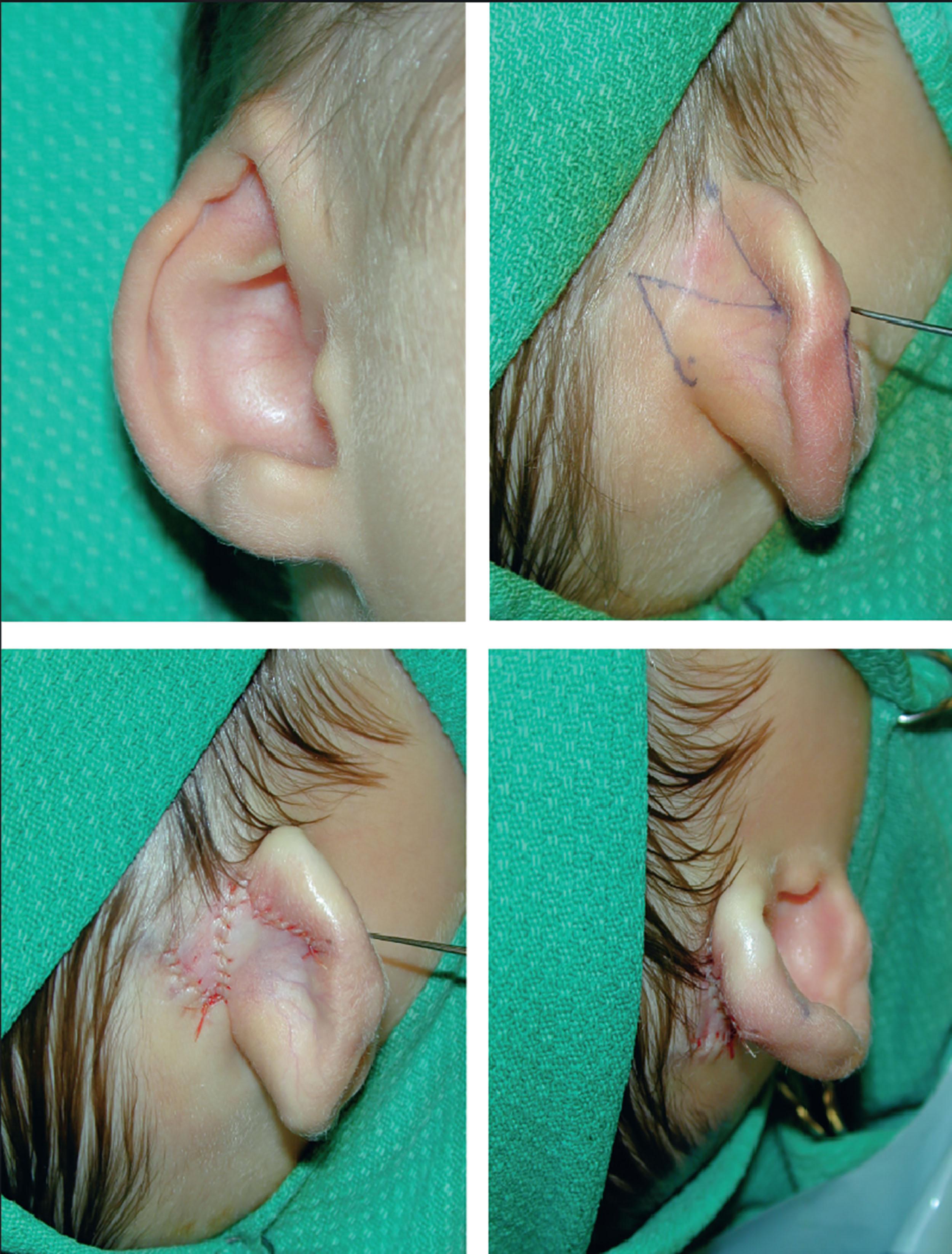
Stahl’s ear deformity is characterized by an accessory third crus and is associated with flattening or deformity of the helix. The best opportunity to treat a Stahl’s ear deformity is using ear molding techniques. Molding therapy, if initiated early, can correct the deformity; surgery on the other hand is difficult and less predictable. Surgical correction therefore is reserved for patients who present later ( Fig. 4.9 ). Surgical methods can be divided into cartilage-sparing or cartilage-cutting techniques. Cartilage-sparing techniques are usually suitable for thin or pliable cartilage and can be achieved using sutures to change the contour of the cartilage. Cartilage-cutting techniques, including excision, are reserved for thicker and stiffer cartilage. The disadvantage of excisional techniques is the resultant reduced size of the ear. Liu et al . described both a cartilage-sparing and cutting technique where the posterior cartilage is scored and full-thickness cartilage cuts are used to contour a superior crus. The authors have found that results are variable, and revisions are frequent.
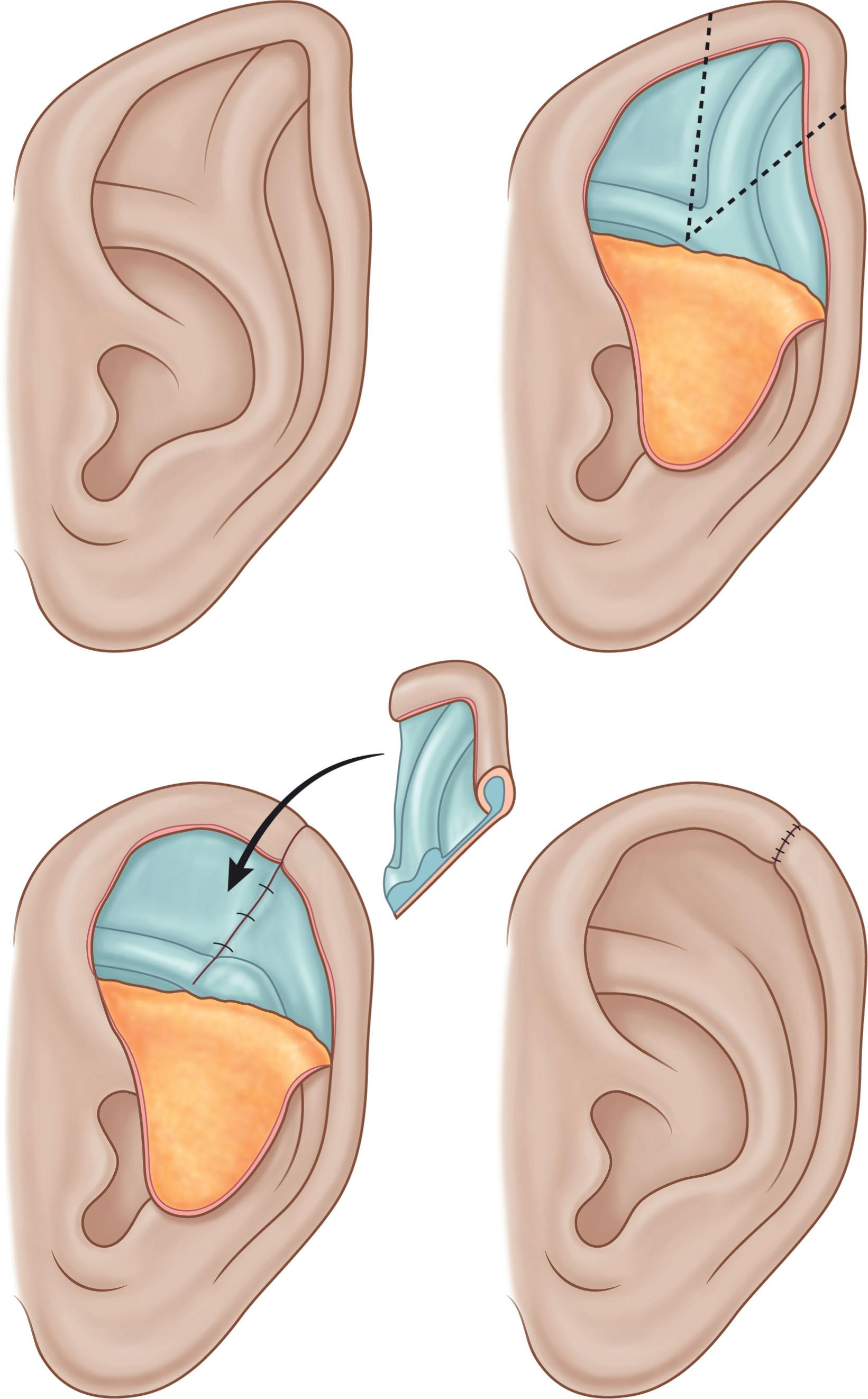
In 1975, Tanzer first described and classified the constricted ear deformity as having the impression that the helical rim has been tightened by a purse string. Tanzer’s classification includes three main groups that define the defect and associated treatment (see Table 4.1 ). Fig. 4.10 illustrates the Musgrave technique for correction of a type IIA constricted ear. Several other techniques have been described using similar principles of fanning the cartilage along with elevation of skin flaps for soft-tissue coverage. More severe cases may require additional cartilage and local soft-tissue flaps for skin coverage.
| Classification | Treatment |
|---|---|
| Type I: Involves the helix |
|
|
|
| Type III: Extreme cupping |
|
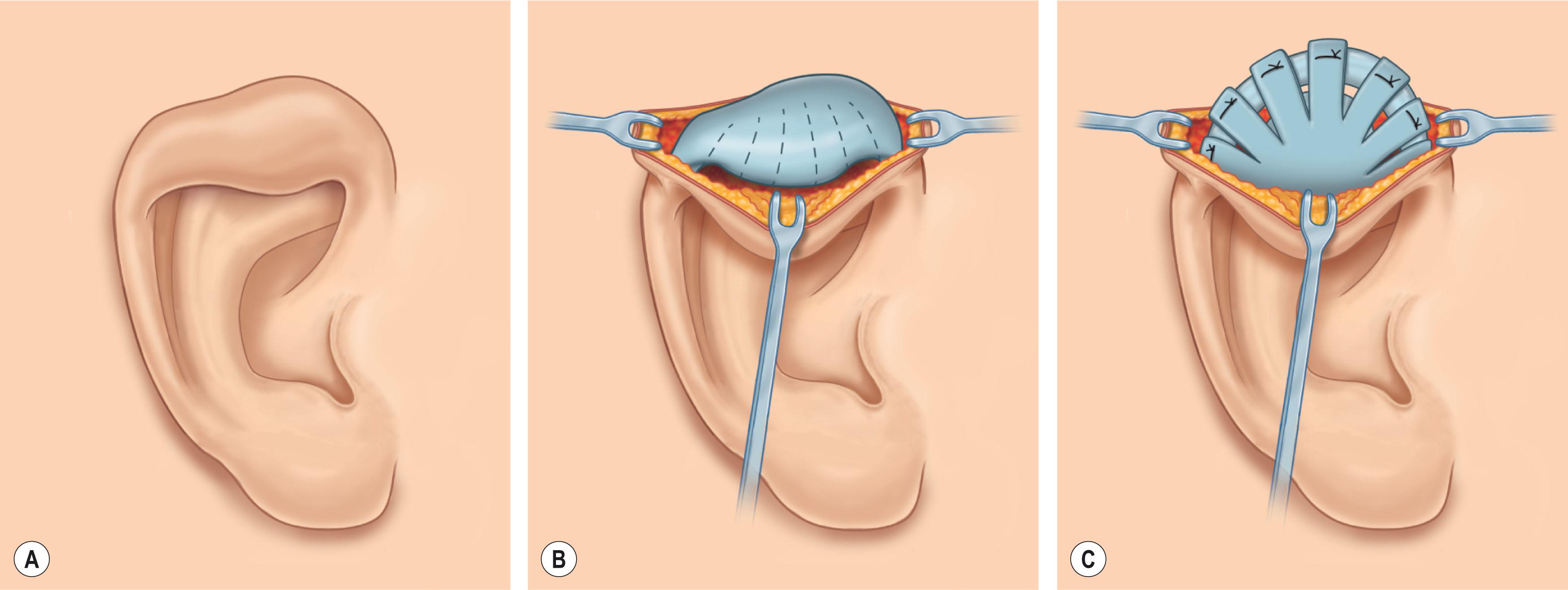
Chul Park developed a new classification and management algorithm for the treatment of constricted ear based on a 22-year, 144-ear experience. His opinion is that constricted ear should be considered separate from microtia. This classification is based on the amount and etiology of lidding and cupping, the cartilage strength, the amount of cartilage shortage as well as the use of two tests, the helical tubing, and scapha-helix push. The “tubing test” involves correcting the ear by sinching the antihelix using two forceps to recreate the antihelical fold and medializing the helix. The “push-back test” involves using a Q-tip to push the scapha medially to correct the prominence and cupping. The classification involves four types of ears. For type I ear, the deformity is completely corrected using the tubing test. Surgical correction can be obtained with Mustardé type sutures to recreate the antihelical fold. For type II ears, the deformity is corrected only with both the antihelical tubing and scapha push-back tests. Surgical reconstruction requires a “tumbling concha-cartilage flap”. For this technique, a conchal cartilage flap is tunneled posteriorly and secured to the helix to tether and buttress the helix posteriorly. A mastoid cartilage flap suture is added to secure the flap to the mastoid periosteum. Type III ears are incompletely corrected using the antihelical tubing and scapha push-back tests. Surgical correction is achieved using the 8th costal cartilage. The graft is secured posteriorly with mattress sutures to recreate the antihelical fold and to buttress the superior third of the ear. Type IV ears cannot be corrected using the antihelical tubing and scapha push-back test due to cartilage and soft-tissue deficiencies. Surgical correction requires both the use of a free-floating cartilage graft and the use of one of four types of skin flaps: a Grotting flap, fasciocutaneous Grotting flap, pre-auricular skin flap or TPF flap. We encourage the reader to refer to this case series, classification, and treatment algorithm described by Park and Park.
Like Nagata, we consider Tanzer type IIB, III, IV ears to be forms of large conchal type microtia, necessitating microtia reconstruction techniques.
Minor congenital ear defects such as accessory tags, malformed tragi, and clefts are generally treated on a case-by-case basis. We direct the reader to Françoise Firmin’s text in which she describes various techniques for addressing minor congenital ear defects.
Several classification systems have been developed for microtia. Tanzer classified congenital ear malformations into five categories. Nagata’s classification of microtia is treatment-based and the illustrations can be seen in Fig. 4.11 . Firmin’s classification is also treatment-based. A more detailed description of the above classification can be seen in Table 4.2 .
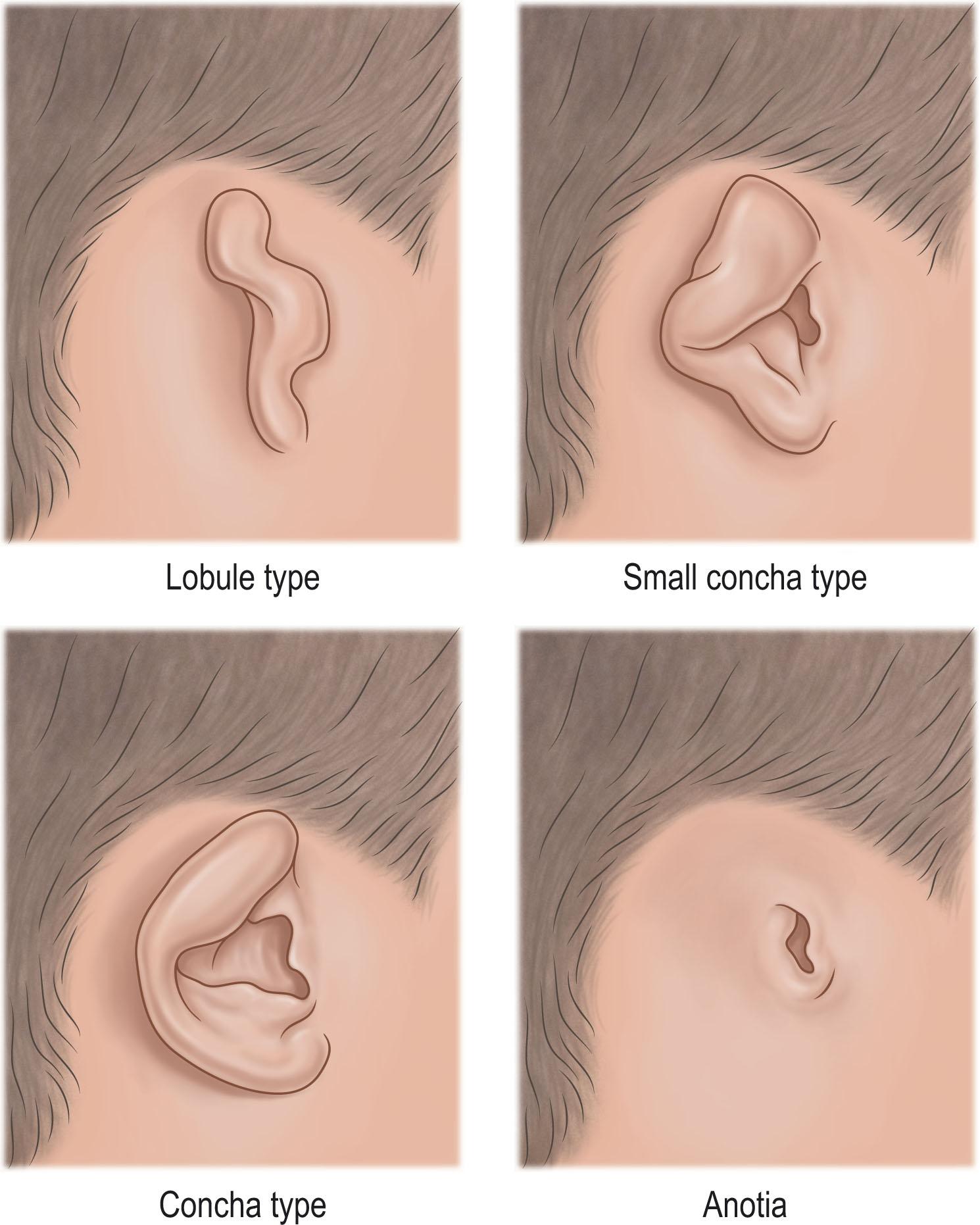
| Tanzer | Nagata | Firmin |
|---|---|---|
|
|
|
In addition to a general medical history, a focused history related to hearing loss, previous investigations, and surgeries for inner or middle ear anomalies should be obtained. The presence of an early atresia repair or a bone anchored hearing appliance (BAHA) is important to note as these may impact certain reconstructive options.
As already discussed, microtia is associated with specific syndromes such as craniofacial microsomia and Treacher Collins syndrome. These syndromes are frequently associated with known anomalies and often require complex surgical interventions throughout growth and development. The timing of previous and future planned facial procedures should be considered.
The type of microtia should be determined. The Nagata and Firmin classifications are recommended because they are treatment-oriented. The position, quality, shape and size of the vestigial ear should be assessed relative to the contralateral ear. The position of the hairline should be evaluated to assure that there is an adequate surface area of non-hair-bearing skin available to cover a 3-dimensional framework, otherwise a TPF flap/skin graft or laser hair removal will be required. The surrounding skin should be examined for factors that might complicate matters; previous surgery, trauma, dermatologic conditions, e.g., acne and eczema, vascular anomalies, etc. Additional embryologic remnants such as pre-auricular tags or pits may be present and should be documented. Facial asymmetry and facial nerve paralysis or weakness may require additional surgeries. Coordination of these surgeries needs consideration, particularly if other surgical teams will be involved. The contralateral ear needs to be examined carefully. Any minor deformities and degree of projection should be documented.
Patients with microtia should routinely be referred to audiology and otolaryngology for evaluation. Maintenance of hearing in the contralateral ear is imperative. The otolaryngologist will provide options for binaural hearing and may suggest computed tomography (CT) scanning to assess the patient’s candidacy for middle ear surgery.
Become a Clinical Tree membership for Full access and enjoy Unlimited articles
If you are a member. Log in here